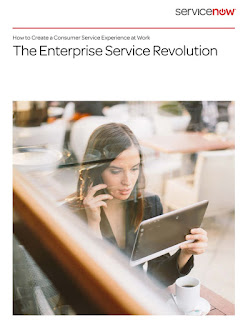 |
| Source: ServiceNow report. |
“Consumers are accustomed to using mobile and cloud technology in their daily lives, but this doesn’t translate to the way they approach their work,” said Jimmy Fitzgerald, VP, Asia Pacific and Japan, ServiceNow. “Companies need to stop living in the past and streamline their workplaces processes through the extraordinary solutions available to them.”
The report surveyed 100 Singaporean managers, comparing their experiences with consumer services and with workplace enterprise services. The company surveyed 2,400 managers globally to rate their experiences with popular consumer services as well as typical enterprise services, such as opening a purchase order, requesting help from another department, ordering equipment, or tracking down information. The survey found that most enterprise services are still based on technology introduced in the 1990s and fall short of the modern consumer service experience.
A ranking, The Service Experience Index, quantifies how beneficial and intuitive services are at work and beyond. In general, ServiceNow found that ease of requesting and fulfilling work services fell behind consumer services on all eight criteria used for the index:
- Services are easy to request or order
- The entire process of the services from request to delivery is fast
- The services can be accessed via a mobile device to check the status or request
- It’s quick to find what services or products are available
- Alerts on status of the request are provided
- Alerts on estimated delivery times are provided
- It’s easy to compare services with others available
- Recommendations are provided based on previous selections
Singapore ranked highest on The Service Experience Index for work services compared to Australia, France, Germany, US, and UK, but even then its score was only an average of 35 on a scale of 0 to 100. Singapore scored an average of 61 for consumer services reflecting the reality that at work, managers are almost six times more likely to use email and, conversely, eight times less likely to use a mobile app than for consumer services.
ServiceNow explains that the gap is driven by outdated technologies that reduce productivity:
· Nearly all (94%) of managers use email to request services
· Slightly over a quarter (27%) of managers use the web or a mobile app to request work services, versus 85% for consumer services
· If only mobile channels are considered, 7% of managers tap mobile apps for workplace services
· Six in 10 managers spend more than three hours at work processing work emails and 84% of them agree that the need to constantly monitor their email makes it difficult to drive tasks to completion. Eighty-six percent of them also feel pressure to answer work emails outside of standard work hours
Automation will drive improvement in the workplace, but it has to be the latest type of automation, ServiceNow said. At present:
· A third of Singaporean companies use mostly automated processes for workplace services. When a business service is mostly automated, 58% of managers say it is easy to request, and 36% say the entire process from requesting to receiving is fast
· However, even the most automated of those workplace services cannot match up to the type of experience available with consumer apps. Only 33% of managers can use their mobile device to make a request in the workplace compared to 72% for consumer services, for example, while just over a quarter (27%) of managers say that they receive notifications of estimated delivery times, compared to 59% for consumer services
ServiceNow suggests that companies close the gap between consumer service experiences and those at the workplace by streamlining processes and injecting automation. Concrete steps to take include:
- Identifying work tasks that require coordination among employees or across departments
- Outlining the coordination process and then defining what it should be
- Designing an intuitive, frictionless interface for employees
- Tapping into consumer-like techniques such as portals, workflows and catalogues
- Tracking and analysing the services to finetune the process.
Interested?
Read the Today’s State of Work: The Service Experience Gap report
*ServiceNow commissioned Lawless Research to design and conduct a study about the state of work in companies with 500 or more employees. Research Now, an independent market research company, hosted the online survey and provided respondents from their panel.
The 10‑minute survey was fielded between March 25 and April 4, 2016 in Australia, France, Germany, Singapore, the US and the UK. A total of 2,400 managers (100 in Singapore) who supervise at least one employee and use interdepartmental services completed the survey.
The margin of error for the study is ±2.0 percentage points at the 95% level of confidence. Tests of significant difference were conducted to the 0.01 level (99% probability that the difference is real, and therefore not by chance).